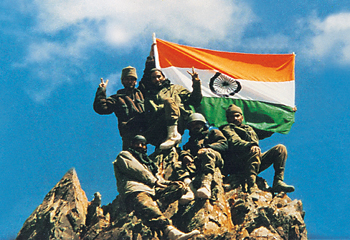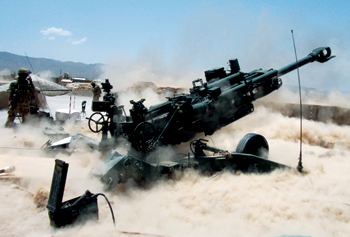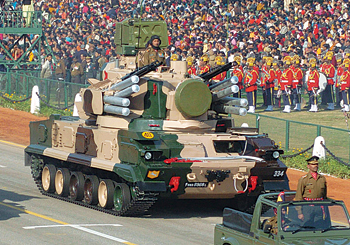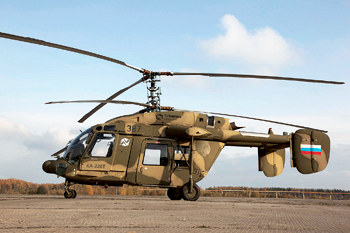INDIAN ARMED FORCES CHIEFS ON
OUR RELENTLESS AND FOCUSED PUBLISHING EFFORTS

SP Guide Publications puts forth a well compiled articulation of issues, pursuits and accomplishments of the Indian Army, over the years

I am confident that SP Guide Publications would continue to inform, inspire and influence.

My compliments to SP Guide Publications for informative and credible reportage on contemporary aerospace issues over the past six decades.
- Interim Defence Budget 2024-25 — An Analysis
- Union Defence budget 2024
- Indian Army: In quest of greater firepower and policy recommendations for gaps
- Indian Army Annual Press Conference 2024
- 6G will transform military-industrial applications
- Tata Boeing Aerospace Delivers 250 AH-64 Apache Fuselages, Manufactured in India
Kargil War and the Current State of Modernisation
What made the conflict unforgettable and distinctive was the sheer guts and bravery shown by our young officers and soldiers in assaulting dominating heights occupied by the Pakistani troops in high altitude terrain where a normal person struggles to breathe the rarified atmosphere with low oxygen content at heights of around 5,000 metres (16,000 feet) above sea level

Kargil War



Kargil Sector is 168 km along the line of control (LoC) stretching from Kaobal Gali in the west to Chorbat La in the east. The sector is vast with the line of control running along the watershed at heights 4,000 to 5,000 metres high. The frontage and the nature of terrain was such that large gaps between defended areas were inevitable. The deployment in the brigade sector included one infantry battalion at Dras; two infantry battalions and a BSF battalion covering Kargil, while Chorbat La was held by Ladakh Scouts. As indications of Pakistani intrusion started pouring in commencing from May 3, 1999, it became clear that armed intruders had occupied heights in the gaps between all defended areas in the sector. It also, gradually, became apparent that India was facing an attempt by Pakistan to change the alignment of LoC in its favour by using its regular troops of Pakistan Army, something which became common knowledge as the conflict progressed but Pakistan as usual kept denying it. Seeing Pakistani moves, India moved a fresh division to the Kargil Sector. The entire story of the various battles is unique but that is not the subject of this article.
There were three stages to the Kargil War. First stage involved Pakistani regulars posing as mujahedeen infiltrating across the line of control in Indian territory and occupying strategic locations and heights enabling it to bring National Highway 1 (NH 1) within the range of its observed artillery fire. The second stage consisted of India discovering the infiltration and mobilising forces to respond to it. The third and final stage involved major battles by Indian and Pakistani forces resulting in India recapturing most of the territories (strategic locations) held by Pakistani forces and the subsequent withdrawal of Pakistani forces back across the line of control after international pressure.
Unforgettable and Distinctive Battles
What made the conflict unforgettable and distinctive was the sheer guts and bravery shown by our young officers and soldiers in assaulting dominating heights occupied by the Pakistani troops in high altitude terrain where a normal person struggles to breathe the rarified atmosphere with low oxygen content at heights of around 5,000 metres (16,000 feet) above sea level. For the Indian Army it was this spirit of the infantry soldier and its young officers, and their fortitude and raw courage, and the lethal firepower of our 155mm Bofors artillery howitzers which accomplished what may be termed as impossible missions in the most daunting terrain of the Kargil Sector where all the odds were against the attacker, in this case the Indian Army. It was the spirit of its soldiery which won the nation the honour and the army the glory, the victory and the adulation of its people.
Unexceptional Weaponry and Inadequate Ammunition
It is the same conflict in which the then Army Chief, General V.P. Malik, had to comment: “We shall fight with whatever we have,” indicating the inadequacies in equipment and munitions. It once again brought to the fore that the Army was short of desired weaponry and ammunition. At that time the lesser known fact is that the army was woefully short of artillery and some other categories of ammunition and had the war expanded to other sectors and had it been fought for a longer duration it would have presented the nation and the army with huge problems. Once again the political leadership had failed the armed forces. This fact did emerge but was successfully hidden under the carpet in the aftermath of victory.
It is the same conflict in which the then Army Chief, General V.P. Malik, had to comment: “We shall fight with whatever we have,” indicating the inadequacies in equipment and munitions. At that time the lesser known fact is that the army was woefully short of artillery and some other categories of ammunition.
The question which arises is that have we learnt any lessons from the past? Have our political leaders started taking more interest in modernisation of the armed forces? Is our current equipment status any better?
Pace of Modernisation after Kargil
During the UPA I and II the situation had deteriorated considerably and it was widely acclaimed that the new NDA Government would rectify the situation. However, the current pace is too slow, and the hide bound and bureaucratic attitude of all stakeholders despite having a technology savvy Defence Minister is the main cause apart from lack of funds. The modernisation of the services is well behind the schedule. In this article we are focusing on the modernisation of the army only.
The ‘Make in India’ rhetoric sounded good for electioneering but it has not changed the ground situation because we do not have the technology or the knowhow to make modern weaponry and our procedures are out of tune with reality. Hence our policies do not match the capabilities desired despite all the political rhetoric about national security. And this is at a time when our threats and challenges have become far greater than they were 17 years earlier during the Kargil conflict.
Today we lack everything from basic weaponry comprising assault rifles and carbines to artillery guns and night-fighting aids. Our reconnaissance and surveillance means are antiquated and the Army Aviation is in a dire state which compelled the wives of the pilots to approach the Defence Minister to replace the obsolete machines of the aviation corps which are killing our pilots.
Current Equipment Scenario
An update on some of the equipment projects undertaken and which are in various stages of development/procurement is given in the succeeding paragraphs.
Assault Rifles
The Indian Army has relaunched its quest for an imported assault rifle, after recently rejecting the locally designed option, in order to plug a vital operational gap. The army is once again preparing its global request for information (RFI) for 7.62x51mm assault rifles instead of its earlier proposal to induct the Defence Research and Development Organisation (DRDO)-designed Excalibur 5.56x45mm rifle. The Excalibur is an upgraded version of the DRDO’s Indian Army Small Arms System (INSAS) 5.56x45mm rifle that entered service with the Indian Army in the mid-1990s, but was rejected by it in 2010, for being ‘operationally inadequate’. The current stance is at variance with the Army Chief of Staff General Dalbir Singh’s earlier declaration that the army would acquire the Excalibur. The Army Commanders Conference in New Delhi in April 2016, however, overturned this choice and the army has unanimously opted to import the more powerful 7.62x51mm rifle for its infantry battalions and its100 odd counter-insurgency units (both Rashtriya Rifles and Assam Rifles). In September 2015, the Ministry of Defence (MoD) terminated its 2011 tender to import 66,000 multi-calibre assault rifles, as none of the four competing models qualified.
Carbines
The MoD is in the process of finalising the outcome of the 2010 tender for 44,618, 5.56mm close quarter battle (CQB) carbines, trials for which concluded in 2013. Israel Weapon Industries (IWI) ACE carbine was shortlisted over the Italian rival Beretta’s ARX-160 model, but over the past few months the contract has run into procedural problems and could well be scrapped and retendered, army sources said. The army, which has been operating without a carbine since 2010 after retiring the licence-built World War II Sterling submachine gun, has an urgent requirement for 1,60,800 CQB carbines.
Artillery Firepower
As part of its Artillery Modernisation Plan, the army is looking at inducting several types of howitzers through in house manufacture by DRDO/Ordnance Factory Board (OFB), inter-governmental pacts and global tenders. The last major acquisition of towed gun-howitzers was that of 400 pieces of 39 calibre 155mm FH-77B howitzers with a range of 30 km from Bofors of Sweden in 1987. This gun proved its mettle in the Kargil conflict. After about 25 years of neglect attempts are now afoot to fulfil its long-postponed 1999 Field Artillery Rationalisation Plan (FARP), under which the army aims to import, locally develop, and licence-produce some 2,820-3,000 assorted 155mm howitzers to equip its artillery regiments for an estimated $8-9 billion. These include 1,580 towed gun systems (TG S), 814 mounted gun systems (MGS), 100 self-propelled howitzers (SPHs) – all of which are 155mm/52 calibre – and 145 BAE Systems M777 155mm/39 calibre ultra lightweight howitzers. Locally upgraded and retrofitted guns will make up additional numbers. While many projects, are afoot none has fructified.
In December 2015 the MoD began price negotiations with Larsen & Toubro (L&T) for 100 modified South Korean SPHs, worth around $800 million. The K9 Vajra-T, an L&T version of Samsung Techwin’s K9 Thunder 155mm/52 calibre gun customised for India’s 2012 SPH tender, was shortlisted for acquisition in late September 2015 following trials the previous year. In these the K9 bested Russia’s MSTA -S selfpropelled gun, which had been modified to 155mm/52 calibre standard and mounted on a T-72 tank chassis.
Similarly in the towed category of howitzers, France’s Nexter Systems, with its Trajan 155mm/52 calibre howitzer modified for the Indian tender of 2011-12, and Elbit of Israel’s AT HOS 2052 gun were required to undergo the supplementary trials from mid-2015 after completing desert and high-altitude firings in 2013-14. The army plans to acquire 400 guns under the Defence Procurement Procedure’s (DPP) ‘Buy and Make’ category and licence-build the remaining 1,180 towed howitzers.
In May 2015 the MoD approved the import of 145, M777s, 155mm ultra light howitzer, along with Selex Laser Inertial Pointing Systems (LINAPS) via the US foreign military sales (FMS) programme. The M777 purchase is to equip the army’s 17 Mountain Strike Corps, which is presently being raised for deployment along the disputed border with China. This deal has been in the process since 2008.
In the meanwhile, the OFB have also been tasked to produce a 45-calibre 155mm howitzer based on the transfer of technology (ToT) obtained from Bofors in the 1980s. The Defence Acquisition Councial (DAC ) approved a proposal from the OFB to manufacture 144 pieces of 155mm/45-calibre howitzers with the option to acquire another 400 provided the prototypes successfully meet the army’s GSQR (General Staff Qualitative Requirement) in user trials. So we can see that while many projects for enhancing our artillery firepower are afoot, nothing has materialised till date.
Armour
Presently the army is hard put to maintain its current fleet of Arjun tanks because of lack of spares. The Arjun tank is indigenous in name only because a large number of its systems and parts amounting to about 60 per cent, are still imported.
The development of Arjun Mark II tank with a large number of improvements has commenced and technical trials incorporating the improvements have been carried out in Rajasthan. However due to unsuccessful trials especially concerning the main armament of the tank in which problems are being encountered in integrating the antitank guided missiles to fire through the main 120mm tank gun, further delay is expected in series manufacture of the Arjun Mk II.
As per media reports the army has till now inducted around 780, T-90 tanks out of a total 1,657 T-90S tanks it eventually wants. The defects in feeding the ballistic data of various lots of ammunition fired from the tanks has now been brought under control.
The T-72 M1 modernisation programme under Project Rhino is inordinately delayed. This was intended to extend the service life of the MBT by 20 years; enhance their accuracy with new fire control system (FCS) whose trials have been completed. However, when all modifications will be completed is not known.
Future Infantry Combat Vehicle (FICV) Programme
On February 15 six local companies submitted their project reports for the army’s Rs. 1,00,000 crore Future Infantry Combat Vehicle (FiCV) programme which was initiated in 2008-09 but abandoned three years later, and resurrected once again in 2014. The FiCV project is a ‘test case’ for India’s indigenous weapon-designing capability
The bids are from five private sector companies that have technology tie-ups with overseas vendors and the OFB. They will design and build 2,610 tracked, amphibious and air-transportable 20-tonne FICVs to replace the army’s ageing fleet of Russian BMP-2/2K Sarath ICVs under the DPP’s ‘Make (Indian)’ category.
MoD has appointed a 10-member Integrated Project Management Team (IPMT), headed by a two-star army general who will evaluate the bids and shortlist two development agencies (DA) that will build one FICV prototype each within 24-36 months
Air Defence
Considering the high costs of new weapon systems, the army is going in for weapon upgrades for L-70, ZU-23-2 Twin gun, and ZSU-23-4 Schilka. Meanwhile, the army is looking for successors to L-70 and the ZU-23-2. Successor to Schilka (ZSU-23-4) already exists in the form of Tangushka, but in limited numbers. A request for information has already been issued to find a replacement for Schilka.
The list of voids and obsolescence of army’s major weapon systems is alarming. This happens to a force when it is neglected by the government for a long period of time as it has happened in the case of the army.
In the missile systems, Kvadrat (mediumrange) and OSA-AK (short-range) are also at the end of their life-cycle. They were to be replaced by Akash and Trishul surfaceto- air (SAM) missiles. Trishul has been foreclosed and Akash is being inducted for semi-mobile roles. For air defence of mechanised units, it has been planned to acquire medium-range SAM (MR-SAM) and quick reaction SAM (QR-SAM) systems.
Army Aviation – Helicopters
Presently the Army Aviation Corps (AAC) has in its inventory the light observation class (Cheetah and Chetak) mostly. These helicopters are obsolete and have been in service since the 1960s and require immediate replacement. As per the latest information in this field the AAC is likely to receive licence-built Russian Kamov Ka-226T ‘Hoodlum’ light multi-role helicopters from 2018 onwards. The Hindustan Aeronautics Limited (HAL) is likely to form a joint venture with Russian Helicopters to licence-build 200 Kamov Ka-226T ‘Hoodlum’ light multi-role helicopters. The public-sector HAL is scheduled to produce the first of 140 twin-engine Ka-226Ts within two years for the AAC and the Indian Air Force (IAF) at a new facility in Tumakuru, 74 km north of Bengaluru.
Conclusion
The list of voids and obsolescence of army’s major weapon systems is alarming. This happens to a force when it is neglected by the government for a long period of time as it has happened in the case of the army. We have only covered four arms of the army. If every arm and service of the Indian Army is considered for filling up of voids and modernisation the list will indeed be endless. How are the army and the government planning to make up these shortages and voids if the funding remains at the current scale? If we carry out a realistic analysis of the budget requirements (maintenance and modernisation) for a 40 division army, a 42 squadron air force and 150 platform navy, the Services will require 3 to 4 per cent of the GDP as their budget minus the defence pensions. Will this ever be possible?
The work culture of our DPSUs also needs to be looked into. In a scathing assessment, the latest CAG report given in the Economic Times on July 27, 2016, dealing with the Army Projects of 2007-12, the central auditor said defence public sector units have miserably failed in meeting the objective of self-reliance, with a majority of contracts entrusted to them facing delays, hampering the capability enhancement plans of the Indian Army .The report, which echoes the sentiments of the private sector that has been battling the government for more orders and is upset that a majority of contracts in the last two years have gone to PSUs. During 2007-12 period, 63 per cent of the contracts given were delayed for various reasons.“Besides impacting defence preparedness, the delay had financial implications towards loss of interest on payments made to defence public sector units. The objective of selfreliance in defence production had also not been achieved.” This report was tabled in Parliament on July 26, 2016.
Thus let us look at ourselves with a view to carry out self-introspection regarding defence modernisation. Have we improved our equipment status since the Kargil conflict? The obvious answer is NO, and in fact we have, as per the existing inventory of equipment, deteriorated further.





